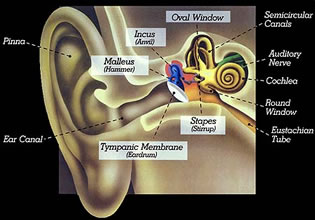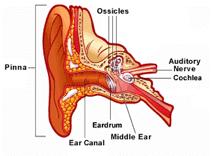
HEARING IMPAIRMENT
 |
Introduction
Have you ever heard a ringing or buzzing sound in your ears after going to a party, concert, or other really loud event? This condition is called tinnitus, and it usually lasts until your ears gradually readjust to normal sound levels. Experiencing tinnitus or having to yell to be heard are both signs that the environment you're in is too loud.
Going to concerts or blasting your stereo once in a while is common. But over time, too much exposure to loud noise can lead to a condition known as noise-induced hearing loss (NIHL). Personal music players are among the chief culprits of NIHL among teens. Video games, television sets, movie theaters, traffic, and some machines and appliances can also make the environment too noisy for the average person. In fact, many experts believe that people are losing their hearing at much younger ages than they did just 30 years ago.
In addition to noise-induced hearing loss, other types of hearing impairment can affect people during their teen years. Unlike hearing loss that's caused by noise, though, these types of hearing loss are not preventable.
Some people are born with hearing impairment — and kids and teens can lose their hearing for many reasons. If you don't know anyone who is deaf or hearing impaired, chances are you will someday. So what causes hearing impairment, and what it's like to live without being able to hear in a world full of sounds?
How the Ear Hears
Think about how you can feel speakers vibrate on your sound system or feel your throat vibrate when you speak. Sound, which is made up of invisible waves of energy, causes these vibrations.

Hearing begins when sound waves that travel through the air reach the outer ear or pinna, which is the part of the ear you can see. The sound waves then travel from the pinna through the ear canal to the middle ear, which includes the eardrum (a thin layer of tissue) and three tiny bones called ossicles. When the eardrum vibrates, the ossicles amplify these vibrations and carry them to the inner ear.
The inner ear is made up of a snail-shaped chamber called the cochlea, which is filled with fluid and lined with thousands of tiny hair cells (outer and inner rows). When the vibrations move through this fluid, the tiny hair cells translate them into electrical nerve impulses and send them to the auditory nerve, which connects the inner ear to the brain. When these nerve impulses reach the brain, they are interpreted as sound. The cochlea is like a piano so that specific areas along the length of the cochlea pick up gradually higher pitches.
This may seem like a long process, but it happens almost instantly. The school bell rings and you know you need to get to your next class. The phone rings and you automatically pick it up. You hear a question and immediately respond to it. But in reality, every time you hear a sound, the various structures of the ear have to work together to make sure the information gets to your brain.
What Is Hearing Impairment?
Hearing impairment occurs when there's a problem with or damage to one or more parts of the ear.
The degree of hearing impairment can vary widely from person to person. Some people have partial hearing loss, meaning that the ear can pick up some sounds; others have complete hearing loss, meaning that the ear cannot hear at all (people with complete hearing loss are considered deaf). In some types of hearing loss, a person can have much more trouble when there is background noise. One or both ears may be affected, and the impairment may be worse in one ear than in the other.
The timing of the hearing loss can vary, too. Congenital hearing loss is present at birth. Acquired hearing loss occurs later in life — during childhood, the teen years, or in adulthood — and it can be sudden or progressive (happening slowly over time).
According to the National Institute on Deafness and Other Communication Disorders, about 28 million Americans are deaf or hearing impaired. That's about 1 out of every 10 people. Another 30 million are exposed to hazardous noise levels on a regular basis. Hearing loss is also the most common birth anomaly.
What Causes Hearing Impairment?
The most common cause of conductive hearing loss in kids and teens is otitis media, which is the medical term for an ear infection that affects the middle ear. Ear infections cause a buildup of fluid or pus behind the eardrum, which can block the transmission of sound. Even after the infection gets better, fluid might stay in the middle ear for weeks or even months, causing difficulty hearing. But this fluid is usually temporary, and whether it goes away on its own (which is usually the case) or with the help of medications, once it's gone a person's hearing typically returns to normal. Blockages in the ear, such as a foreign object, impacted earwax or dirt, or fluid due to colds and allergies, can also cause conductive hearing loss.
People also get conductive hearing loss when key parts of the ear — the eardrum, ear canal, or ossicles — are damaged. For example, a tear or hole in the eardrum can interfere with its ability to vibrate properly. Causes of this damage may include inserting an object such as a cotton swab too far into the ear, a sudden explosion or other loud noise, a sudden change in air pressure, a head injury, or repeated ear infections.
Sensorineural hearing impairment results from problems with or damage to the inner ear or the auditory nerve. Its causes include:
How Do Doctors Diagnose It?
Hearing loss can be difficult to diagnose in infants and babies because they haven't yet developed communication skills. Often babies are screened before they leave the hospital to see if they have hearing loss. Sometimes parents may begin to notice that the baby doesn't respond to loud noises or to the sound of voices.
Certain symptoms in teens should prompt a trip to the doctor. According to the American Speech-Language-Hearing Association, you should let your parents or doctor know if:
The doctor will usually examine a person's ears and, if necessary, refer someone with these symptoms to an audiologist, a health professional who specializes in diagnosing and treating hearing problems. The audiologist will do various hearing tests that can help detect where the problem might be. For example, to test the function of the inner ear, the audiologist can put a special device behind the ear that transmits tones directly there. This helps to distinguish between inner ear and middle or outer ear problems.
A person may also need to see an otolaryngologist), a doctor who specializes in ear, nose, and throat problems.
How Is It Treated?
Treatment for hearing loss varies depending upon the cause of the hearing impairment. Treatment may involve removing wax or dirt from the ear or treating an underlying infection. If there is damage or a structural problem with the eardrum or ossicles, surgery may help to repair it. If the problem is with the cochlea or hearing nerve, a hearing aid or cochlear implant may be recommended.

Hearing aids come in various forms that fit inside or behind the ear and make sounds louder. They are adjusted by the audiologist so that the sound coming in is amplified enough to allow the person with a hearing impairment to hear it clearly. Sometimes, the hearing loss is so severe that the most powerful hearing aids can't amplify the sound enough. In those cases, a cochlear implant may be recommended.
Cochlear implants are surgically implanted devices that bypass the damaged inner ear and send signals directly to the auditory nerve. A small microphone behind the ear picks up sound waves and sends them to a receiver that has been placed under the scalp. This receiver then transmits impulses directly to the auditory nerve. These signals are perceived as sound and allow the person to hear.
Depending upon whether someone is born without hearing (congenital deafness) or loses his or her hearing later in life (after learning to hear and speak, which is known as post-lingual deafness), medical professionals will determine how much therapy the person needs to learn to use an implant effectively. Many people with implants learn to hear sounds effectively and even use the telephone.
More than 65,000 people around the world have received cochlear implants and about one third of them are children.
Some patients with hearing loss and their families may decide not to restore hearing. This is particularly true of children whose parents are hearing impaired and want their children to be able to function in the deaf community. The language of the deaf community is American Sign Language (ASL). ASL is a system of gestures many deaf and hearing-impaired people use to communicate.
Can I Prevent Hearing Impairment?
Many cases of hearing loss or deafness are not preventable, however it is very important to realize that hearing loss caused by loud noise can be prevented. The only cause that can be prevented is noise-induced hearing loss. There are steps you can take to reduce your risk of this type of hearing loss.
The intensity of sound is measured in units called decibels, and any sounds over 80 decibels are considered hazardous with prolonged exposure. These include things like loud music, sirens and engines, and power tools such as jackhammers and leaf blowers.
To reduce the risk of permanent hearing damage, you can:
What's Life Like for People Who Are Hearing Impaired?
For people who lose their hearing after learning to speak and hear, it can be difficult to adjust because hearing has been an essential aspect of their communication and relationships. The good news is that new technologies are making it possible for more hearing-impaired teens to attend school and participate in activities with their hearing peers. These technologies include programmable hearing aids, which teens can adjust for different environments; FM systems, which include a microphone/ transmitter worn by the teacher and a receiver worn by the student; cochlear implants; real-time captioning of videos; and voice-recognition software, which can help with note taking.
Many hearing-impaired teens read lips and use ASL, and in some cases an interpreter may be available to translate spoken language in the classroom. Some teens may attend a separate school or special classes offered within a public school. And for hearing-impaired people who want to go to college, many universities in the United States will accommodate their needs. One college, Gallaudet University, in Washington, DC, is dedicated entirely to hearing-impaired students.
At home, devices such as closed-captioned TVs, lights that flash when the doorbell or phone rings, and telephones with digital readout screens (called telecommunications devices for the deaf, or TDDs) are often helpful. Family and friends of people who use ASL or lip reading can help by learning to use sign language or, if the person uses lipreading, by speaking slowly, clearly, and face to face.
Disclaimer: This information is not intended be a substitute for professional medical advice. It is provided for educational purposes only. You assume full responsibility for how you choose to use this information.
Reviewed by: Robert C. O'Reilly, MD, and Thierry Morlet, PhD
Date reviewed: June 2006